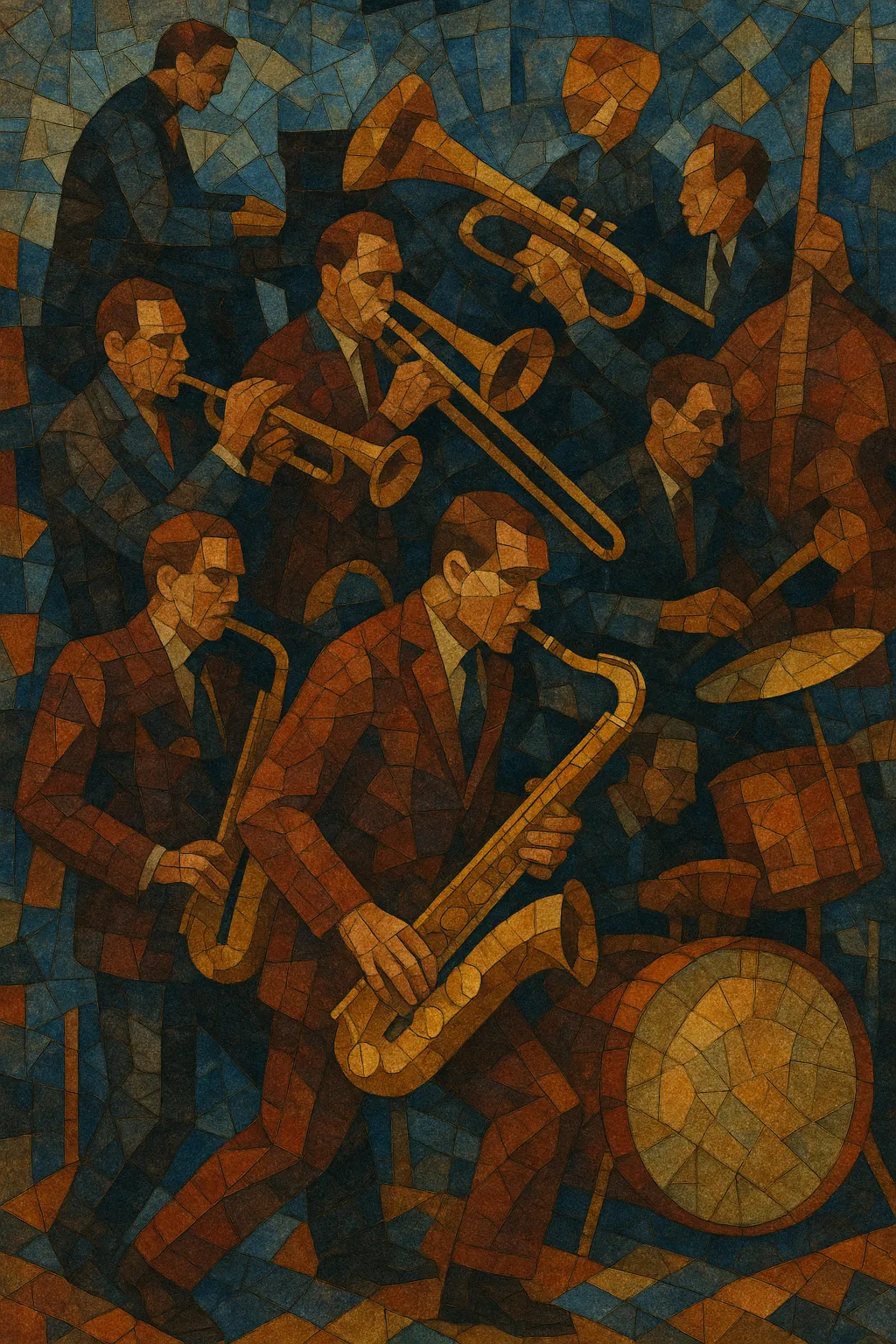
Progressive big band is a post–World War II evolution of big band jazz that shifts the focus from dance music to concert-oriented, highly arranged works.
It preserves the massed brass-and-reeds power of swing-era ensembles, but adopts bebop’s advanced harmony and lines, classical orchestration techniques, and ambitious, often through-composed forms. Arrangers favored expanded instrumentation (French horns, tuba, Latin percussion, sometimes strings), dense voicings, polytonality, and dramatic dynamic contrasts, yielding a bold, modernist “concert jazz” sound.
Compared with swing, the rhythm can alternate between a hard-driving 4/4, even-eighth feels, Latin grooves, and unusual meters, while sections trade contrapuntal lines more than riff-based call-and-response. The result is an epic, sometimes imposing aesthetic that bridged jazz and contemporary classical ideas.
After WWII, several bandleaders sought to move beyond dance-hall swing. Stan Kenton popularized the term “progressive jazz” in 1947 and soon assembled larger, brass-heavy orchestras that emphasized concert presentation over ballroom function. At the same time, Boyd Raeburn and Woody Herman’s Second Herd absorbed bebop’s advanced harmony and lines into big-band frameworks, while Claude Thornhill’s cool, pastel textures and innovative orchestrations (with French horns and tuba) pointed toward a more symphonic palette. Afro-Cuban currents—via arrangers and collaborations tied to Machito and others—brought modern Latin grooves and orchestrational color into the repertoire.
Kenton’s Innovations in Modern Music Orchestra (1950–51) made the case for big band as modern concert music—through-composed suites, expanded percussion, and dramatic brass sonorities. Key arrangers such as Pete Rugolo and Johnny Richards advanced polytonal harmony, cluster voicings, and complex counterpoint. Dizzy Gillespie’s big band showed how bebop vocabulary could thrive at orchestral scale, and Gil Evans refined an approach that fused jazz phrasing with contemporary classical colors, setting the stage for later orchestral-jazz milestones.
Progressive big band aesthetics fed directly into third stream thinking (the intentional fusion of classical procedures with jazz) and inspired later innovators such as Don Ellis and Maynard Ferguson, whose bands embraced odd meters, rock backbeats, amplified rhythm sections, and formidable brass pyrotechnics. The era’s jazz-rock and jazz-fusion movements adopted the progressive big band’s appetite for scale, timbral variety, and structural ambition.
Although dance-oriented swing receded, the progressive big band validated the big ensemble as a vehicle for modern composition and orchestration in jazz. Its practices—expanded instrumentation, sophisticated harmony, and concert-hall forms—remain foundational for contemporary jazz orchestras, film/TV scoring idioms, and conservatory-trained big bands worldwide.
Start with a classic big band: 5 saxes (alto/alto/tenor/tenor/baritone—with doublings on flute/clarinet), 4 trumpets, 4 trombones (including bass trombone), piano, bass, drums. Expand the palette with French horns, tuba, Latin percussion, mallet instruments, and occasional strings.
Use extended tertian harmony (9ths, 11ths, 13ths), planed clusters, polytonality, and occasional bitonality. Favor dense, sectional voicings and cross-section orchestration (e.g., trumpets with clarinets and flutes) to achieve new colors. Employ modern voice-leading: contrary motion, upper-structure triads over altered dominants, Lydian/modal colors, and pedal points for tension.
Alternate swinging 4/4 with straight-eighth driving feels, Afro-Cuban grooves (mambo, cha-cha, bolero), and odd meters (5/4, 7/8, 9/8). Layer rhythmic cells across sections to build polyrhythmic textures. Drums should balance set-piece figures (kicks) with long arcs of coloristic cymbal work.
Write beyond the head–solo–head: use multi-movement suites, through-composed arcs, or sectional forms with recurring motives. Employ thematic transformation—reharmonize, re-orchestrate, invert, and sequence motives across the ensemble. Balance virtuosic soli passages with space for improvisation.
Provide precise articulations, detailed drum cues, and clear roadmaps for metric modulations. Mark solis and background figures meticulously so improvisations integrate with written material.
Draw lines from bebop and post-bop language but set them in symphonic frames. Incorporate Latin montunos, modern counterpoint, and dramatic cadential suspensions to achieve the style’s concert-jazz grandeur.

